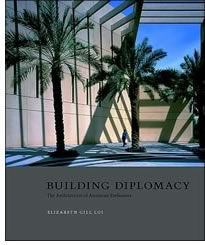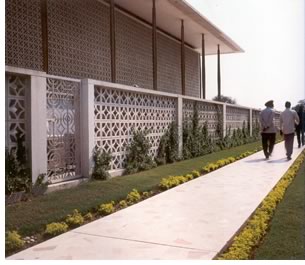

11/2004
Building Diplomacy, The Architecture of American Embassies, by Elizabeth Gill Lui
(2004, Distributed by Cornell University Press, in association with Four Stop Press)
 reviewed by Tracy Ostroff
reviewed by Tracy Ostroff
If you have ever longed for credentials for an insider’s tour of some of the most prestigious symbols of democracy and diplomacy, your paperwork has arrived. A new publication, Building Diplomacy, The Architecture of American Embassies, by fine artist and photographer Elizabeth Gill Lui, assisted by screenwriter Keya Keita, is your passport to American diplomatic enclaves around the world. Beginning with a preface and introductory piece that give context to the images within, the mother-daughter duo team up to provide an absorbing look at the evolution and current state of the face of the buildings through which, Lui writes, “we deliver America’s vision to the rest of the world.”
The main text comprises an introduction and preface by Lui as well as an introductory essay by Washington, D.C.-based architectural historian Jane C. Loeffler, author of The Architecture of Diplomacy: Building America’s Embassies (Princeton Architectural Press, 1998).
 “‘Out of sight, out of mind’ is an adage that may
help explain why embassies have been so frequently overlooked by historians
and why they are so misunderstood by the general public and by elected
officials,” Loeffler writes.
“‘Out of sight, out of mind’ is an adage that may
help explain why embassies have been so frequently overlooked by historians
and why they are so misunderstood by the general public and by elected
officials,” Loeffler writes.
To quell these misconceptions, Loeffler describes the many ways in which the development of the program, and the diplomatic architecture it engendered, reflects a “tangible expression of America’s official overseas presence.” As an example, she points to the buildings designed by SOM’s Gordon Bunshaft in post-war Germany. “Having recently completed the trend-setting, sleek, glass-enclosed Lever House office tower in New York City, Bunshaft designed each of the much smaller German buildings in the same style to recall design innovations that had their roots in German Bauhaus. Since it was so important for postwar diplomacy to sow the seeds of democracy where a totalitarian regime had been vanquished, Bunshaft and architecture critics who assessed his work also cited the transparency of the International Style as a metaphor for the openness of America’s political system.”
 Loeffler
explains how State Department officials decided to finance their post-war
building program using foreign credits or war debts, which led to the
purchase of sites for new construction in Asia, Africa, Europe, and the
Pacific, as well as buildings in Paris and Rome. Foreign Buildings Operations
(FBO) Chief Architect Leland King, Loeffler notes, “enthusiastically
endorsed Modern architecture for its inviting optimism—a stark
contrast to the ponderous classicism of typical Soviet structures. In
this quest, he hired Harrison & Abramovitz (Rio de Janeiro and Havana
chanceries), Ralph Rapson (Stockholm chancery), and John van der Meulen
(Copenhagen chancery).
Loeffler
explains how State Department officials decided to finance their post-war
building program using foreign credits or war debts, which led to the
purchase of sites for new construction in Asia, Africa, Europe, and the
Pacific, as well as buildings in Paris and Rome. Foreign Buildings Operations
(FBO) Chief Architect Leland King, Loeffler notes, “enthusiastically
endorsed Modern architecture for its inviting optimism—a stark
contrast to the ponderous classicism of typical Soviet structures. In
this quest, he hired Harrison & Abramovitz (Rio de Janeiro and Havana
chanceries), Ralph Rapson (Stockholm chancery), and John van der Meulen
(Copenhagen chancery).
Although admired for their newness and what was then a high-tech look, the buildings also drew criticism from traditionalists who urged a return to a classical idiom. From there, the FBO “called on architects to fit designs to place and to respect local themes and traditions,” including Eero Saarinen (London and Oslo, 1959), Marcel Breuer (The Hague, 1959), Richard Neutra and Robert Alexander (Karachi, 1959), and I.M. Pei (Montevideo, 1969). The explanation offers a backdrop for how the U.S. government has protected its workers and carried on diplomacy through today.
 More than a coffee-table book
More than a coffee-table book
To capture Building Diplomacy’s colorful
images, the authors traveled to 47 counties between November 2000 and
July 2003, photographing more than 100 American diplomatic properties
to represent a cross-section of the various styles of American embassies.
Although the book is organized by region, Liu points to examples of each
type in the introduction. Appendices offer a useful guide to the book’s 268 pages.
Although buildings take center stage in this homage to Foreign Service personnel, their interiors and artwork also are featured. Lui’s photographs offer a sense of access and exclusivity architects might wish for if they were framing their own images: No crowds and few individuals to get in the way. Some of the 11x14 and smaller images come with explanatory text, but for others the art and architecture stand on their own. The book is sprinkled with quotations on architecture and diplomacy, beginning with a letter written in 1789 by George Washington to the emperor of Morocco as the two nations formalized America’s first diplomatic relationship.
 Some
might quibble that this is a book more destined for a coffee table than
for the top of the library reading list. To be sure, the art and architecture
are the stars, but the narratives on the history and symbolism of embassy
architecture, and the buildings’ reflection of the world
in which they are designed make a provocative guide to the genre. “As
is appropriate to the social experiment to which we are committed as
a nation, individuality and diversity are in wide evidence in the design
of our embassies,” Lui writes. “And yet issues of security
have come to dominate the perception of these properties to the extent
that even when they are historically significant as architecture they
are described primarily as fortresses or bunkers.”
Some
might quibble that this is a book more destined for a coffee table than
for the top of the library reading list. To be sure, the art and architecture
are the stars, but the narratives on the history and symbolism of embassy
architecture, and the buildings’ reflection of the world
in which they are designed make a provocative guide to the genre. “As
is appropriate to the social experiment to which we are committed as
a nation, individuality and diversity are in wide evidence in the design
of our embassies,” Lui writes. “And yet issues of security
have come to dominate the perception of these properties to the extent
that even when they are historically significant as architecture they
are described primarily as fortresses or bunkers.”
 “Aesthetics tell a story”
“Aesthetics tell a story”
Still, Lui writes, “The political factors that existed after World
War II, which allowed for the openness of Modernist architecture as the
signature style of embassy design, are as revealing of their time as
are today’s political realities, which have mandated the fortification
of America’s missions abroad. At both ends of the spectrum, aesthetics
tell a story.” Concerned that the literal wall of security creates
a disconnect with diplomatic endeavors, Lui laments the “true regret” one
feels “when looking at a crumbling gem of a building such as Harry
Weese’s chancery in Accra, Ghana, decommissioned as an embassy
because it was determined that it could not be secured.” But she
does take heart in the “extreme pride” one feels when “standing
in the atria of chanceries such as those in Ottawa or Riyadh or Moscow,
marveling at the successful integration of aesthetics with the engineering
of such a technologically advanced and secured building type.”
As an early reminder of the inherent danger of Foreign Service work, the authors dedicate the book to the victims of the embassy bombings in Beirut, Lebanon; Nairobi, Kenya; and Dar es Salaam, Tanzania, and list their names in an appendix. Perhaps it is the architectural response to these tragedies that gives Liu some hope for the future. “As a response to a threatening world, I offer this body of work as the affirmation of my belief that we must go forward maintaining a commitment to those humanizing things that are of importance to us, those things that are good and worthwhile and enduring.”
Copyright 2004 The American Institute of Architects.
All rights reserved. Home Page ![]()
![]()
